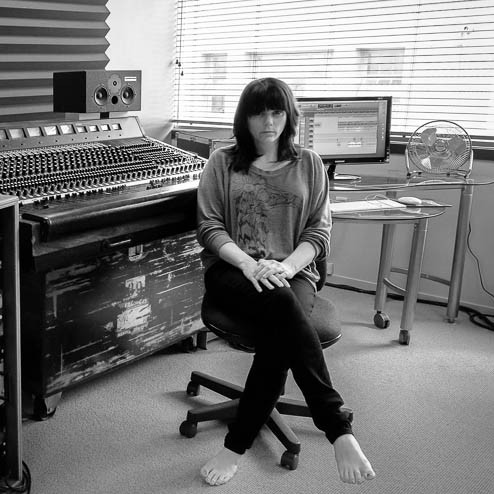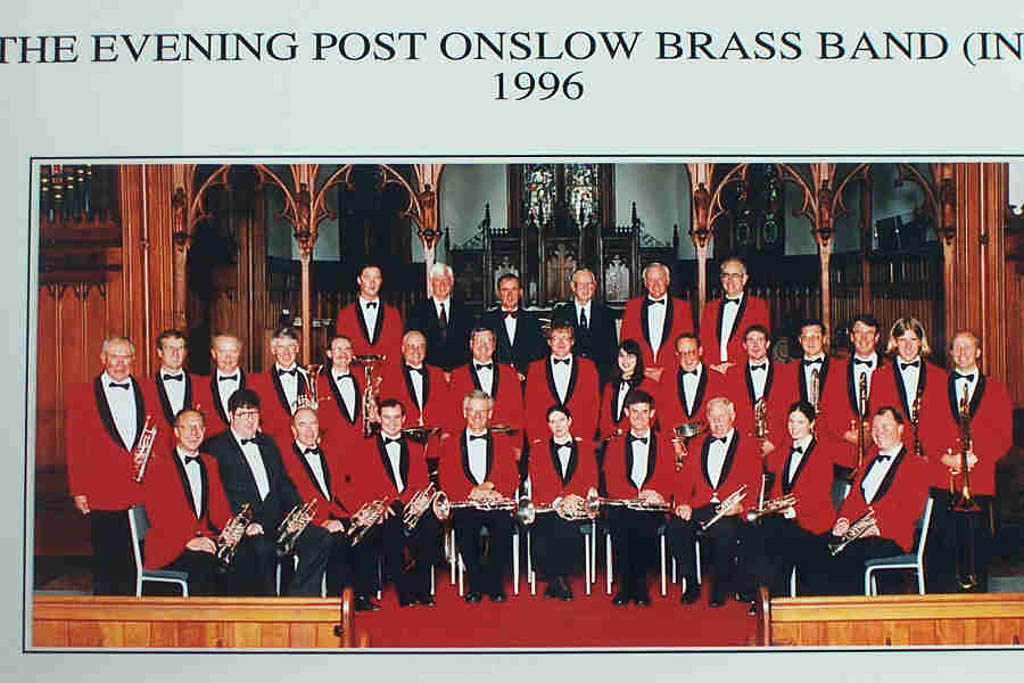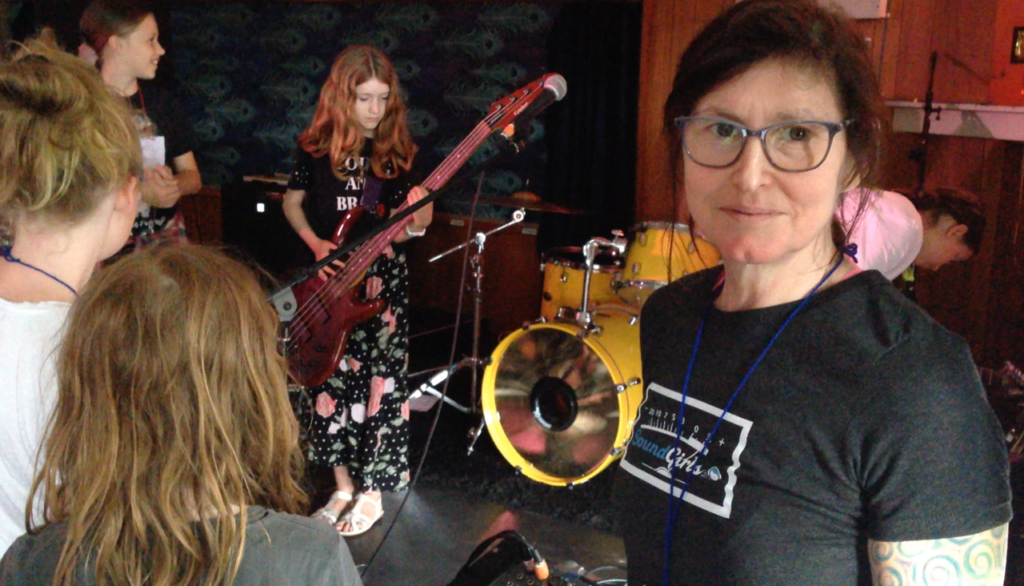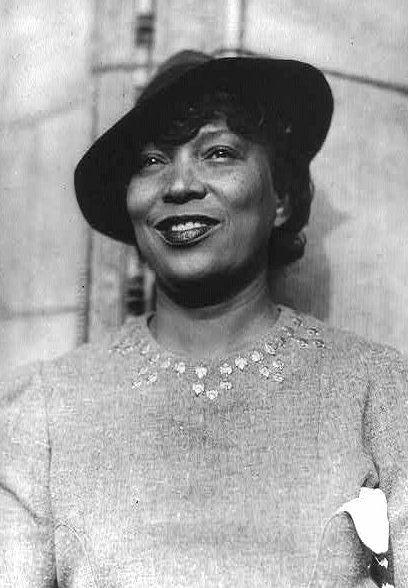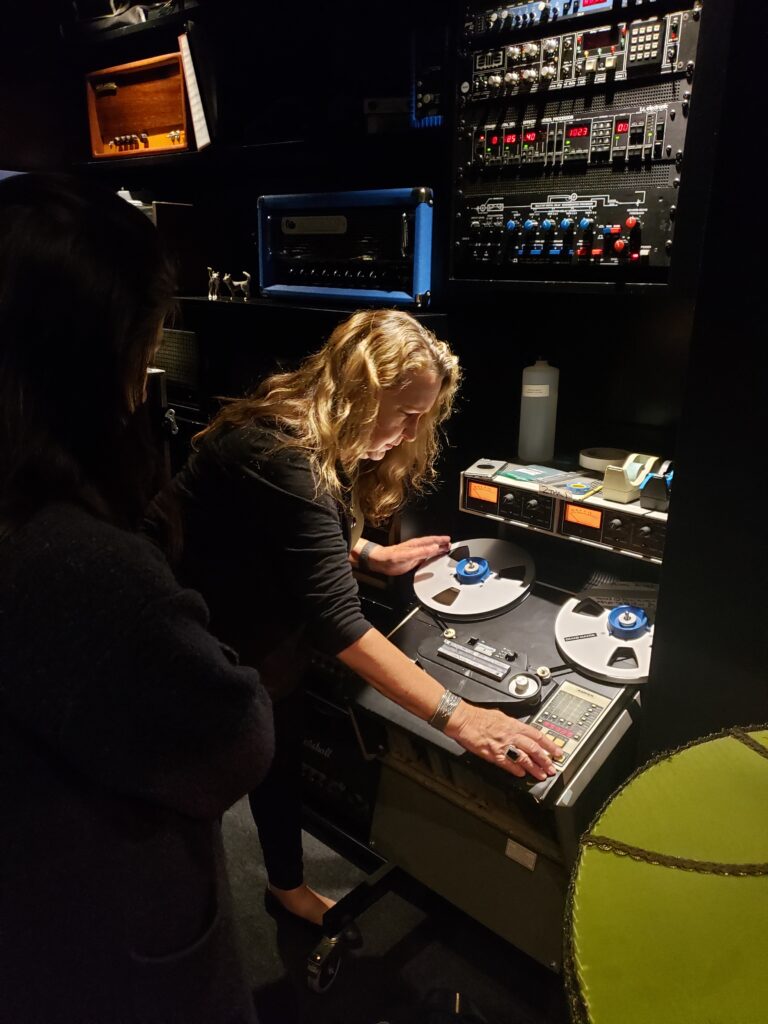GIL EVA CRAIG
Gil Eva Craig is an independent Audio Engineer and Music Producer working in professional audio for the last 18 years. Gil got her start as a recording engineer in 1996 and still owns and operates her own mixing and production studio, The Secret Beehive. This past May, she co-produced an album with Charlotte Yates and has done sound design and written original music for several theatre productions. Her passion though is live sound, and she currently is the FoH Engineer for The Wellington Ukulele Orchestra and works for the family business, Western Audio Engineering.
 Gil’s interest in audio started in her teen years, as she would make ‘multi-track ‘ recordings using her brothers Walkman and the family boom box. Recording a guitar track first on the Walkman and then playing it back off the boom box, while recording a second track with the boom box, recording on the Walkman, and so on and so on. Reflecting back on this tracking technique Gil says “It didn’t take too many generations before my recordings turned to unintelligible satanic hiss”. Eventually, she was able to purchase a four-track cassette recorder, followed by a host of recording setups including; ½ inch 8 track, 1 inch 8 track, adats, 2 inch 16 track, and finally a 24 track hard disc recorder and Protools.
Gil’s interest in audio started in her teen years, as she would make ‘multi-track ‘ recordings using her brothers Walkman and the family boom box. Recording a guitar track first on the Walkman and then playing it back off the boom box, while recording a second track with the boom box, recording on the Walkman, and so on and so on. Reflecting back on this tracking technique Gil says “It didn’t take too many generations before my recordings turned to unintelligible satanic hiss”. Eventually, she was able to purchase a four-track cassette recorder, followed by a host of recording setups including; ½ inch 8 track, 1 inch 8 track, adats, 2 inch 16 track, and finally a 24 track hard disc recorder and Protools.
Gil spent the early years of her career recording and mixing demos for bands while trying to fund her studio. Initially, she was lured to live sound with the promise of fast cash to fund her studio. She started mixing bands at the local bar and quickly found that she not only enjoyed it but preferred it overworking in the studio. She has continued to work in both the studio and live environments. Gil has worked on several theatre productions, in which she has won awards for sound design.
Gil stumbled into sound design for theatre productions, as well as writing original music, when a mutual friend recommended her to a sound designer. She was hired to write music for a production of Penumbra that he was working on. At this point in time, the only theatre experience she had was as a musician in two amateur productions of Shakespeare. Tim Spite, a theatre director, attended the production, liked the music he heard, and hunted her down. He offered Gil the chance to compose and sound design on his next production. Gil continued to work on several of his productions, including a production of December Brother that she won a Chapman Tripp Theatre award for best sound design. The Chapmann Tripp Theatre Awards are New Zealand’s equivalent to the Tony Awards.
Sound Design for theatre productions encompasses two main disciplines; the technical design and the creative design. The technical design includes the speaker and playback system, programming the playback software and the digital consoles. The creative design is the sound effects, atmos, and music.
Gil was recently involved with the production for ‘360, A Theatre of Recollections. The production includes a surround sound and music design, and the audience is seated inside a circular stage, on swivel chairs. Gil programmed the show into a Q lab, and was able to run eight discrete outputs to six surround speakers, overheads, and subs. The sound designer, John Gibson, wrote the score utilizing surround sound to create the illusion of being surrounded by singers and players at key points in the score.
Gil’s extensive music background has surely helped throughout her career. She was trained in classical guitar starting at the age of ten and took up the trumpet when she was fifteen. She briefly played the Soprano Cornet and Flugelhorn, before settling on the Tenor Horn. She played as a musician in several bands, including a “file-under-difficult-listening” art band that was mixed by her future husband. She also played in a Brass Band called The Evening Post Onslow Brass Band.
Playing in the Brass Band provided a brilliant musical education, Gil explains that “playing in an A grade brass band was demanding, as a big part of being in the band was playing in contests. The test music for the A grade is challenging, much of it sonically pushing the boundaries of what can be done with a large brass ensemble. The time spent in rehearsals pulling these amazing and complicated pieces of music apart and making sense of them, coupled with what I learned at university and a modern music course I took, was the best musical education I could have wished for”.
While Gil did not have formal training in sound engineering, as at the time there were not programs offered in New Zealand, she did embark on a degree in music. Eventually, her engineering work took priority and she did not complete her degree. She feels that the time spent on her music degree gave her a solid foundation for sound engineering. She was taught the basics of harmony, counterpoint, orchestration, acoustics, and ethnomusicology. As for the technical side of things, she learned by reading, observing, and hands-on experience.
Hands On – The Family Business
Gil’s husband, is a partner in Western Audio Engineering, a professional live sound production company. For over a decade, the couple lived in the PA workshop (warehouse), which also housed her studio. This allowed her free access to outboard gear and mics for her studio and live gigs, and she found herself surrounded by sound gear 24/7. Instead of flowers on the kitchen table, there was a soldering iron. Gil reflects on her time spent living in the workshop “It was awesome living in the workshop for nine of those years, then I started to hanker for vases of flowers on the kitchen table, and nice vintage glassware that wouldn’t get smashed in a week”.
Currently, Gil works mainly in live sound, and her job duties at Western Audio include whatever needs to be done; stage patching, show prep, loading trucks, equipment maintenance, FOH, and Monitors. Recent gigs at Western Audio have included; mixing the entertainment and anthems for an international netball match, mixing live elements for a wearable art show, a stage patch for a festival, and monitors for a small outdoor festival.
As an independent engineer, Gil mostly mixes FoH, and does a small amount of sound system and playback design for theatre. She tours as the FoH engineer for the Wellington International Ukulele Orchestra, who regularly tour New Zealand and occasionally Australia. She recently shared her experiences mixing them with SoundGirls.Org, you can check it out here: Wellington International Ukulele Orchestra at the Edinburgh Fringe Festival. Gil does monitors for the Pink Floyd Experience, which regularly tours New Zealand and Australia and has done sessions in South Africa.
Gil explains what she enjoys the most about touring “I like that every day is different, but the same, as you are setting up the same rig (give or take a few variables) each day, but are in different places. It’s a perfect blend of routine and novelty. Also, being part of a team, but with a certain amount of independence. Both of these factors completely suits my nature”. She also loves to travel, which fuels her fascination with airplanes and her love of photography. Her days off usually include visiting galleries and museums and taking photographs. The thing she likes the least is finding food, being gluten intolerant is a challenge. Aftershow pizza is out.
Women in sound in New Zealand
New Zealand is a very small country, with only about 4 million people, so women in live sound are fairly scarce! I think I am the only woman who is currently touring. In all the years I have been doing live sound, I have met three New Zealand women working in a technical capacity. One is a good friend of mine and is head of audio for the New Zealand Festival of the Arts. A female engineer is definitely still a novelty to some house guys when I meet them for the first time. When last touring with the Pink Floyd Experience, I got the classic ‘so you sing backing vocals’ a couple of times.
Advice for Women starting out
It is important to learn at least one instrument and be able to read music. Learning to speak the language of musicians is invaluable. Invest in a professional set of earplugs and take steps to protect your hearing. Take time to learn and try out different areas of audio to see where your passion lies and what fits your personality.
Gil feels she would not last in today’s modern recording environment with its emphasis on computer-based recording and pro tools editing. She once worked on a film production and immediately knew that was not a good fit. At some point, you just gotta jump in. I have met two women who have gone through audio school, who have yet to mix a show because they are afraid. I’m still afraid! Just today I agreed to mix a monitor gig and now I’m thinking why the f*** did I say yes? Learn by osmosis and observing, but you have to observe and surround yourself with people who are really good at what they do!
Must Have Skills
Aside from the obvious technical ability, having diverse musical experiences both as a listener and player gives you a huge head start. I’m grateful for every second I spent playing in the brass band, orchestra, guitar and brass ensembles, various pop/rock bands and the howling I did in the file-under-difficult-listening performance art group. Human communication skills: basically really listening to what people say and knowing what questions to ask. Which means you can translate ‘my monitor sounds mongy’ into ‘its right on the edge of feeding back at 250.
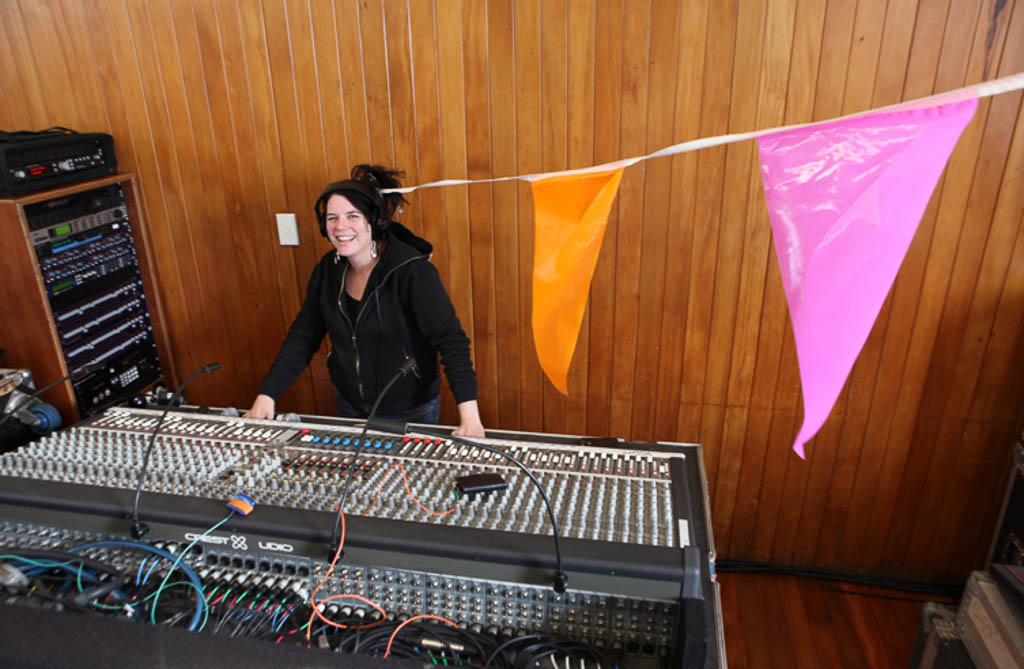
Favorite Gear: I am mad about and completely obsessed with reverbs. My favorites are the Bricasti M7, AMS, lexicons 460 and 300. I am also very fond of the Sony R7, and have a soft spot for the Yamaha Rev 7. I just love them. I haul my Bricasti to all my shows. The one show last year I couldn’t take it to, as we were traveling on a plane so small it was basically a van with wings, I really missed it. The Sony M7 is an underrated treasure, possibly because it’s not easy to program. It’s got its own thing going on sonically.
While I don’t really get overly gooey over microphones, I do really like DPA 4061’s and 4099s. I think they sound great. I used 4099’s on a couple of trombones recently, fantastic. My favorite consoles are Midas digital consoles. I like how they sound and love the VCA and Pop group concept as you can program it so it’s under the fingers, very nice. I have done a few things on the pro 1 lately, which I call the kitten console because it’s impossibly little and cute. When coupled with a DL251 stage box to expand up to 40 channels, it’s amazing what you can do on it.
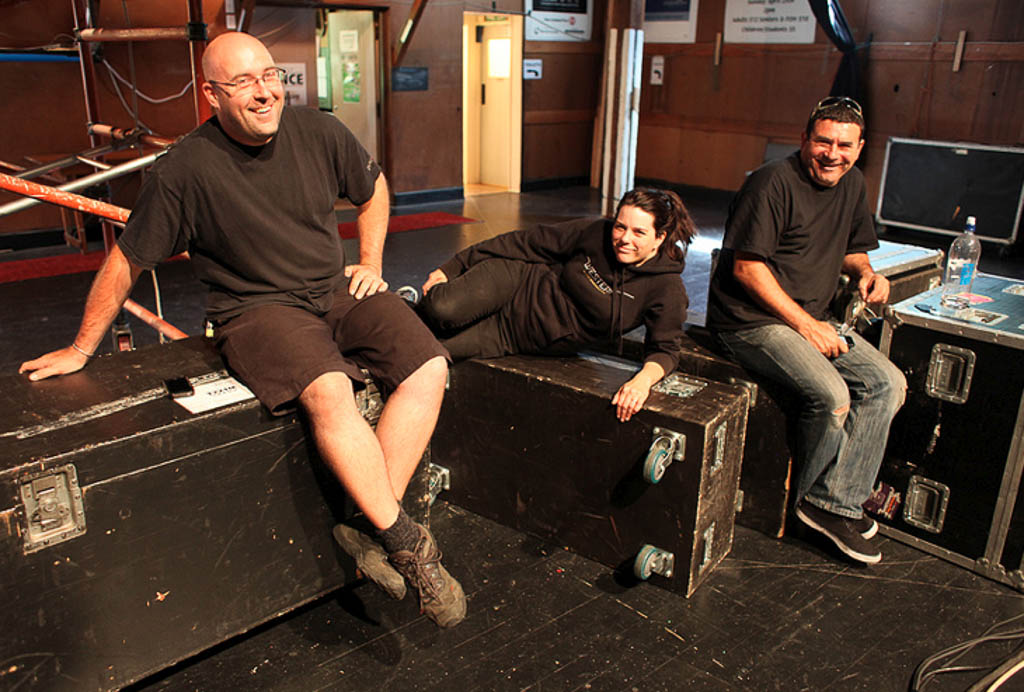 Album mixes:
Album mixes: Charlotte Yates’s Beggars Choice and ‘Archipelago’
Rosy Tin Tea Caddys All Mountains are MenChris Prowse’s Waterfront Collective’s Trouble on the Waterfront’ and The Shiner
Flea Bite’s – In Your Ear and Circus of Fleas
Fatcat and Fishface’s Bird Brain Theatre Sound Design:
-Sound design and music for several of Tim Spites Seeyd Theatre plays, 2006 – 2012, including the award -winning December Brother
-Sound design and music for Ginette MacDonald’s My Brilliant Divorce 2008
-Sound design for Centrepoint Theatres The Raft 2009
-Sound System Design for 2010 New Zealand International Arts Festival show 360
-Sound system design for Chris Wards award winning sound design for The Lead Weight 2011Awards: Gil has been nominated for several Chapman Trip theatre awards, and won best sound design for The December Brother in 2010. She also mixed Tui award winning albums Trouble on the Waterfront by The Waterfront Collective, and Circus of Fleas by Fleabite and tracked another Tui winning album Dog Breath by FatCat and FishFace.Live Sound:
-Wellington International Ukulele Orchestra – FOH engineer
-Pink Floyd Experience – Monitor engineer
-World of Wearable Arts – FOH engineer
-The Woolshed Sessions – FOH engineer
-Rosy Tin Tea Caddy – FOH engineer
-Claude Rains – FOH engineer
History of The English Brass Bands
The English Brass Bands got their start during England’s Industrial Revolution. They were originally organized and financed by mining and milling companies to keep the working classes from politically organizing. In 1860, there were around 750 brass bands in England. Today the English Brass Band tradition is found throughout New Zealand, Australia, Japan, and the United States. The Salvation Army has kept the tradition alive in the United States.
English Brass Bands are made up cornets, flugelhorn, tenor horns, baritones, trombones, euphoniums,B-flat and E-flat basses and percussion. The bands are made up of 28 to 30 members and their programs can include original music, traditional marching songs, hymns, and medleysBands in New Zealand are graded into four levels A grade to D grade. A grade being the top grade, and D being the equivalent of a beginner band. In Britain, the equivalent is 1st – 4th grade, with the addition of the Championship Section. The Championship Section is the best of the best and includes famous bands such as Black Dyke and Grimethorpe.
The contests in New Zealand consist of each band preparing a March, a Hymn, and an original piece. They are also given a set test piece. The A Grade is very competitive, and as the contest becomes closer; the bands practice several times a week, with extensive rehearsals on weekends. Each player is expected to continue practicing at home. Several bands have tempted top players from England by helping them relocate to New Zealand.
